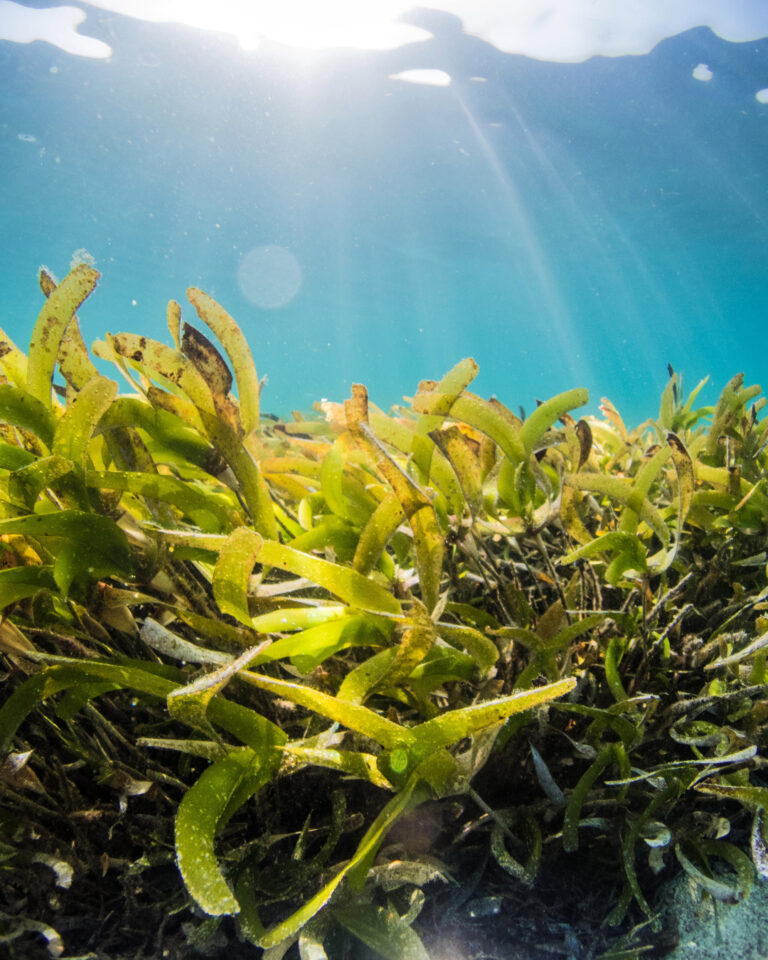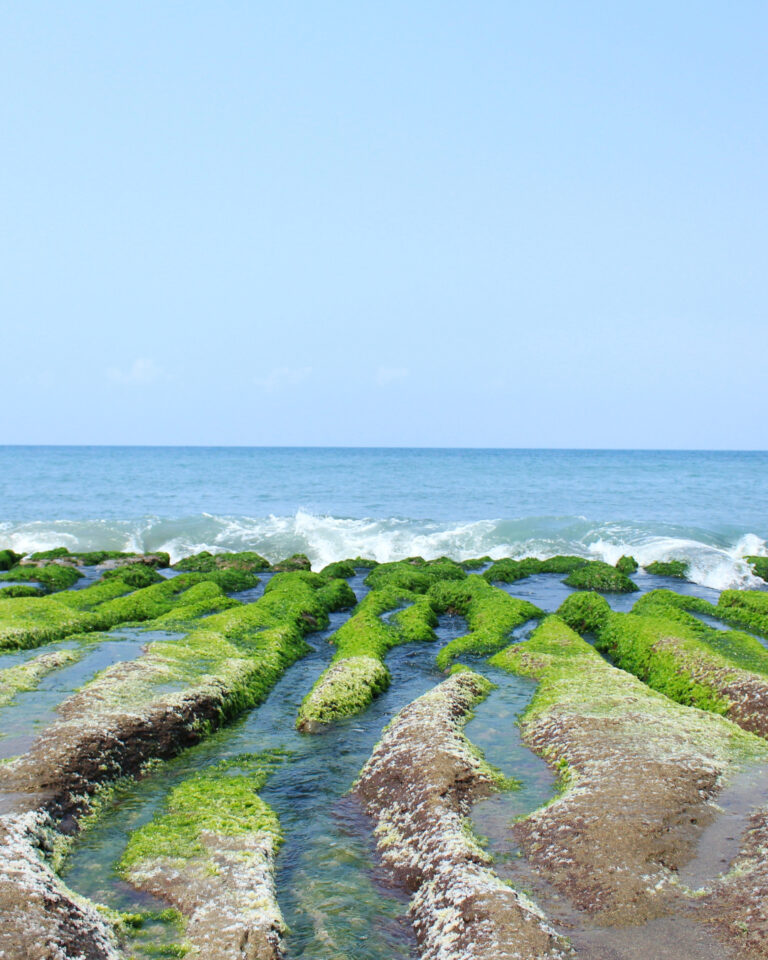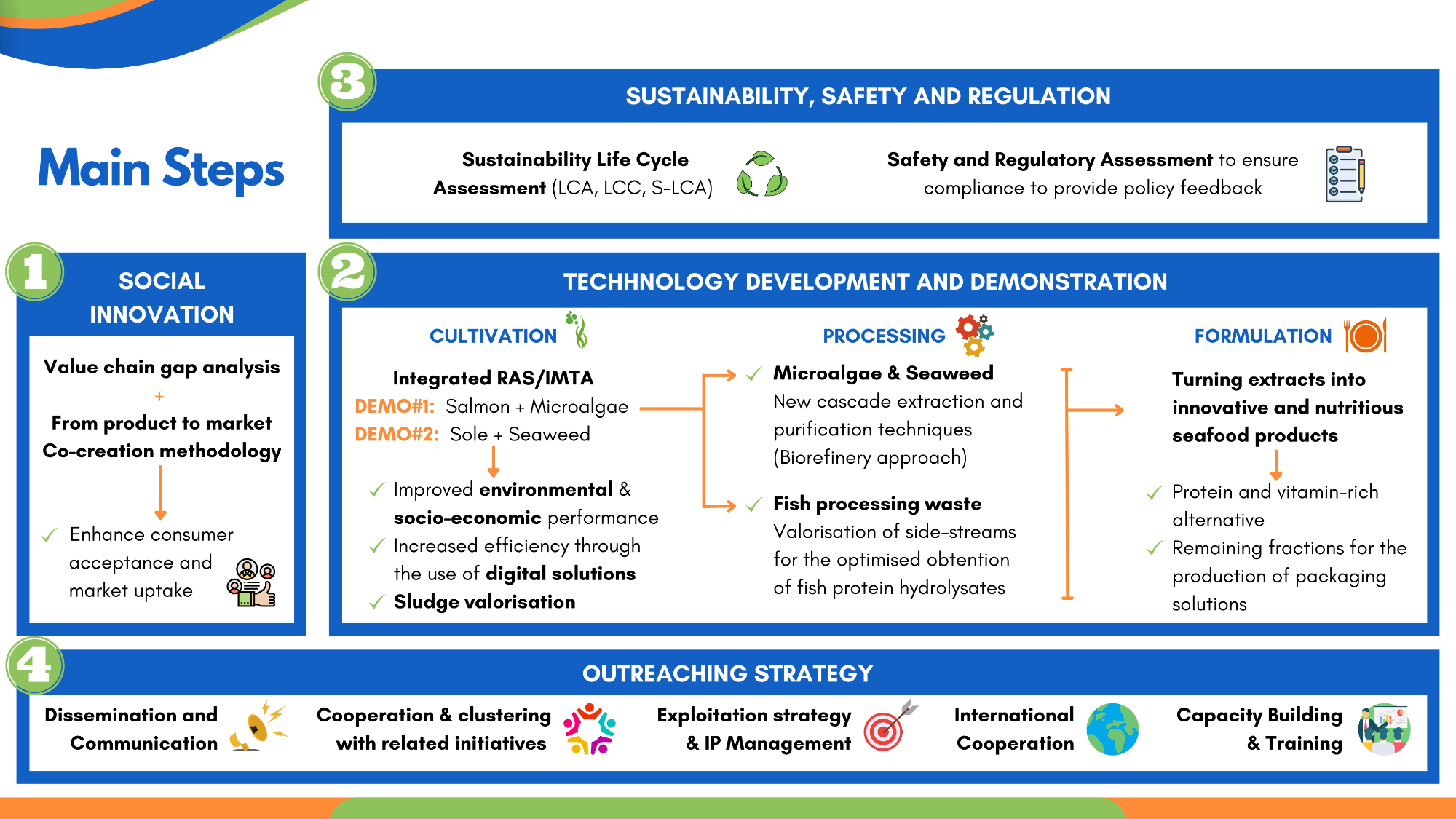Project Background
In a scenario where global food systems are being challenged due to the expected population growth, together with resource impoverishment and other environmental constraints, seafood has been identified as a vital source of food and a key component of a healthy diet.
Nonetheless, decades of unsustainable overfishing practices are depleting aquatic ecosystems at a time when nearly one-fifth of all animal protein consumed by humans comes from seafood, reason why aquaculture has gained traction over wild fisheries. In fact, it has been the fastest-growing food industry globally for several decades and is expected to continue in the coming years despite a slight decrease in the annual growth rate.
However, intensified near-shore aquaculture raises environmental and resource-related questions, mainly due to waste-streams, dependence on wild fisheries for aquafeed, disease outbreaks and the potential introduction of invasive species resulting from escapes in ecosystems where they do not belong.
Hence, to ensure the future viability of the sector and to unlock its potential to provide food with a lower carbon footprint (as stated in the Farm to Fork (F2F) Strategy of the European Green Deal), it is imperative to improve current technologies and management strategies, incorporating circular economy principles, optimising resources, reducing the operational costs, and minimising the environmental footprint. This is especially relevant for the EU sector, where 70% of consumed seafood is imported and the production is concentrated both in terms of countries and farmed species.
There are great opportunities for diversification for the EU’s aquaculture both in the farming of new species (such as non-fed low- trophic species) and production methods (e.g., Integrated Multitrophic Aquaculture (IMTA), Recirculating Aquaculture Systems (RAS)).
In this sense, algae (both microalgae and seaweed) have much potential, both for improving the sustainability of the production processes and as a direct food source to increase the seafood offer to consumers.


Objective and Impact
INNOAQUA’s main objective is to pave the path towards the upcoming sustainable and diversified EU in-land aquaculture industry by leaning on the demonstration and mainstreaming of innovative algae-based foods and solutions and ecology, circularity and digitalization concepts.
INNOAQUA proposes an ambitious and efficient research and innovation (R&I) workplan to develop and mainstream several solutions for the aquaculture industry involving the use of algae.
Relying on a multidisciplinary consortium of renowned research centres, associations and companies with high industrial presence it will:
Demonstrate the feasibility and benefits of multi-trophic in-land cultivation management practices (i.e., integrated RAS and IMTA) enhanced by the use of the latest digital technologies.
Contribute to the improvement of the sustainability and competitiveness of already-established value chains through the implementation of circular economy principles to minimise waste production in cultivation and processing facilities.
Extract high-added value ingredients from algae biomass and fish by-products to be used in the formulation of innovative seafood products, focusing from the beginning on social innovation approaches aimed at improving their societal acceptance and market penetration.
Operational objectives
To implement an ecosystem approach for sustainable management of aquaculture production.
Land-based aquaculture systems offer significant advantages over coastal cage culture, such as improved management with the capacity to predict the outputs of production cycles, the capability to mitigate environmental interactions (escapes, infectious diseases, parasites, etc.) and the potential to be sited “closer-to- market”, delivering fresh seafood with less transportation time and impact to the consumers.
INNOAQUA will contribute in this regard by demonstrating the environmental and socio-economic benefits of integrating fish and algae cultivation at two DEMO sites, using coupled RAS-IMTA systems and aligning culture optimisation with waste management:
- DEMO#1 will demonstrate the integration of RAS Atlantic salmon aquaculture with microalgae cultivation.
- DEMO#2 will demonstrate the scale-up and feasibility of a SMART-IMTA (System for Monitoring and Adaption in Real Time for Integrated Multi-Trophic Aquaculture) system for the combined production of soles (flatfish) and macroalgae.
To demonstrate tools to limit the waste in aquaculture cultivation and processing
Solid wastes, primarily derived from uneaten feed and faecal droppings of cultured fish, have been reported as the most harmful waste in fish culture systems, making their sustainability a public concern. Anaerobic stabilization is considered a potential cost-effective methodology for sludge valorisation but, although it has been used extensively for manure management on terrestrial animal farms and human sewage, its utilization in RAS has not been fully explored.
INNOAQUA will seize the opportunity to boost the alignment of the aquaculture sector with the current European Circular Bioeconomy Strategy by recovering nutrients (N and P) from RAS sludge to produce culture medium for algae cultivation, improving circularity and reducing the need for commercial substrates.
To demonstrate processing methods to obtain new innovative (algae-based) seafood products
Algae are a sustainable source of natural high-value bioactive compounds such as proteins, polyunsaturated fatty acids (PUFAs), carotenoids, bioactive and functional carbohydrates, and vitamins. These components possess numerous benefits for high added value food applications widely sought after in the current market, especially as low carbon protein-rich alternative source.
In INNOAQUA, extraction approaches are integrated into a single pre-commercial scale cascade extraction biorefinery to obtain ingredients that meet food formulators needs, valorising all the microalgae and seaweed biomass.
To enhance the societal acceptance and market penetration of innovative seafood products through novel social simulation approaches
Innovations in the food sector initially focused on the development of the protein-rich alternatives to traditional foods. Recent efforts were concentrated on scaling up the production processes, so the new products can be price-competitive alternatives on the market.
INNOAQUA aims to develop a novel methodological approach that combines two methods: consumer-led NPD (novel product development) and agent-based modelling and simulation. This From Product To Market Co-Creation methodology (FPTM C-C) will be targeted at food innovators, who need a comprehensive approach to introduce a food product to the market.
To maximize wider uptake of INNOAQUA’s results during and after the project’s execution
Raising awareness of aquaculture sustainability issues in Europe, creating favourable business environments, and fostering synergies between aquaculture development programmes and initiatives is as critical as the development of technological innovations themselves.
INNOAQUA is adopting a multi-level outreaching strategy to ensure an effective exploitation and protection of research outputs in commercial (e.g., patent licensing, trade secret) and non-commercial activities (e.g., capacity building and training materials, policy and standardization feedback).
